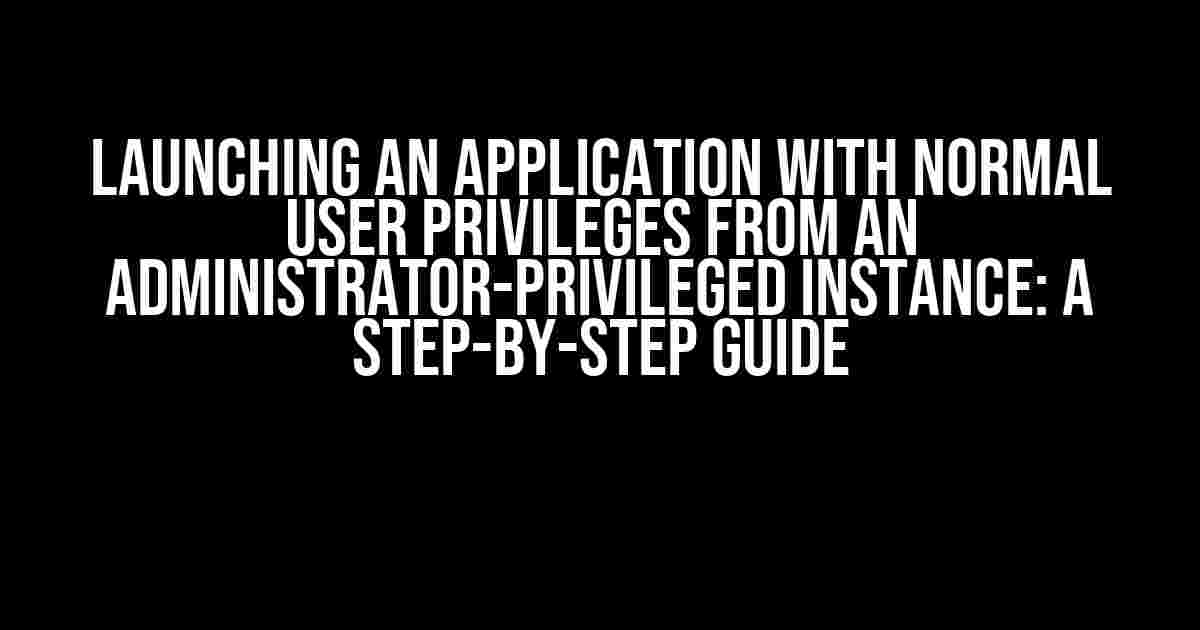A common conundrum many developers face is launching an application with normal user privileges from an administrator-privileged instance. This task may seem daunting, but fear not, dear reader, for we’ve got you covered! In this comprehensive guide, we’ll take you through the process, providing clear and direct instructions to ensure a seamless experience.
Why do we need to launch an application with normal user privileges?
In an ideal world, applications would run with the least privileges required, ensuring security and minimizing the attack surface. However, in some cases, an application might be launched from an administrator-privileged instance, which can lead to security vulnerabilities. By launching the application with normal user privileges, we can:
- Mitigate potential security risks
- Prevent unauthorized access to sensitive areas of the system
- Comply with security best practices
Understanding the concept of elevated privileges
Before diving into the process, let’s quickly review the concept of elevated privileges. When an application is launched with administrator privileges, it inherits the elevated rights, allowing it to access sensitive areas of the system. This can be problematic, as it provides a potential entry point for malicious actors.
In contrast, launching an application with normal user privileges ensures that it operates within the constraints of the user’s account, reducing the attack surface.
Methods for launching an application with normal user privileges
We’ll explore three methods to launch an application with normal user privileges from an administrator-privileged instance:
Method 1: Using the runas command
The `runas` command is a built-in Windows utility that allows you to run a program under a different user account. To launch an application with normal user privileges using `runas`, follow these steps:
runas /user:username "C:\Path\To\Your_Application.exe"
Replace `username` with the desired user account and `C:\Path\To\Your_Application.exe` with the path to your application executable.
Method 2: Using the Task Scheduler
The Task Scheduler provides a convenient way to launch an application with normal user privileges. Here’s how:
- Open the Task Scheduler (taskschd.msc)
- Create a new task and set the “Run whether user is logged on or not” option to “Run only when user is logged on”
- Set the “Run this task with highest privileges” option to “Off”
- Specify the application executable in the “Actions” tab
- Save the task and run it
Method 3: Using a third-party library or framework
Some programming languages, such as C# or Python, offer libraries or frameworks that allow you to launch an application with normal user privileges. For example, in C#, you can use the `Process` class to start a new process with reduced privileges:
using System;
using System.Diagnostics;
class LaunchApp
{
static void Main(string[] args)
{
ProcessStartInfo psi = new ProcessStartInfo();
psi.FileName = @"C:\Path\To\Your_Application.exe";
psi.Verb = "runas";
psi.Arguments = "/user:username";
Process.Start(psi);
}
}
Replace `C:\Path\To\Your_Application.exe` with the path to your application executable and `username` with the desired user account.
Common issues and troubleshooting
When launching an application with normal user privileges, you might encounter some common issues:
| Issue | Solution |
|---|---|
| Application doesn’t start | Verify the executable path and ensure the user account has read and execute permissions |
| Application crashes or behaves unexpectedly | Check the application’s log files for errors and ensure it’s compatible with the reduced privileges |
| User account not recognized | Verify the username and password are correct, and the user account exists on the system |
Conclusion
Launching an application with normal user privileges from an administrator-privileged instance is a crucial step in ensuring the security and integrity of your system. By following the methods and troubleshooting tips outlined in this guide, you’ll be well on your way to achieving this goal.
Remember, security is an ongoing process, and it’s essential to continually monitor and evaluate your application’s privileges to ensure compliance with security best practices.
Stay safe, and happy coding!
Frequently Asked Question
Got questions about launching an application with normal user privileges from an administrator-privileged instance? We’ve got the answers!
Why do I need to launch an application with normal user privileges in the first place?
Launching an application with normal user privileges helps prevent potential security risks associated with running applications with administrator-level access. This approach ensures that even if the application gets compromised, the damage will be limited to the user’s account and won’t affect the entire system.
How do I know if an application is running with administrator privileges?
Check the application’s properties or the Task Manager to determine if it’s running with administrator privileges. You can also look for the “Run as administrator” option in the application’s shortcut properties or right-click menu. If you’re still unsure, try running the application as a normal user and see if it requests elevation.
What are the consequences of launching an application with administrator privileges unnecessarily?
Launching an application with administrator privileges when it’s not necessary can lead to serious security risks. Malicious code can exploit the elevated privileges to gain access to sensitive areas of the system, leading to data breaches, system compromise, and even malware infections.
How can I launch an application with normal user privileges from an administrator-privileged instance?
You can use the “Run as” feature in Windows to launch an application with normal user privileges. Right-click the application’s shortcut, select “Run as,” and then choose the user account you want to use. Alternatively, you can use the “_runas” command in the Command Prompt or create a batch file to automate the process.
Are there any third-party tools that can help me launch applications with normal user privileges?
Yes, there are several third-party tools available that can help you launch applications with normal user privileges. Some popular options include SURun, RunAsRob, and CPAU. These tools provide a convenient way to run applications with limited privileges, ensuring a more secure computing environment.

